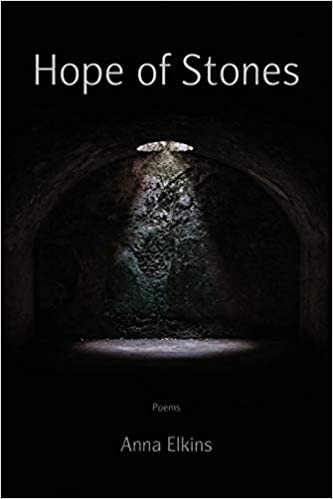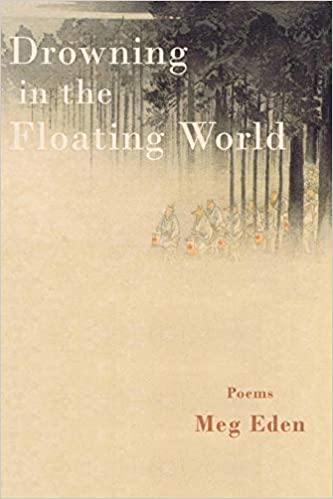
Anna Elkins. Hope of Stones. Press 53. 2020. 65 pages. $14.95.
Anna Elkins’ Hope of Stones is organized around one of the most unusual premises I’ve seen in a collection of contemporary poetry. Two historical figures dominate the collection, Teresa of Ávila, 16th century nun, saint, and author of The Interior Castle, and Charles-Axel Guillaumot, 18th century French architect who created catacombs beneath Paris in order to reinforce tunnels under the city that had been dug to extract building stones. A third figure, the poet, communicates with both, often revealing intersections between them.
The poems are laid out on the page distinctly, with the architect’s aligning with the bottom margin, the nun’s justified right, and the poet’s conventionally justified left and beginning near the top margin. What begins with an author’s obsessive interest in two unrelated persons eventually reveals that very few objects or ideas, not to mention people, are in fact separated from each other. What have stones to do with light, or bones to do with prayer?—as much, it turns out, as imminence has to do with transcendence.
The collection is arranged into three sections, “pray,” “build,” and “wonder.” Each of those words would seem to be affiliated with one of the characters speaking through the collection, but each section includes poems of all three individuals; readers realize that wonder is often a form of prayer, as is building. In attempting to understand the architect and the nun, the poet is also attempting to understand herself, of course, as well as the world and its creator.
In “The Poet, Fasting,” the speaker describes a fast required by a dental procedure, considering how mundane necessity sometimes leads to revelation. “I lie beneath the maple tree on a quilt & watch / the sky beneath branches,” she says. Though her thoughts wander, they remain focused primarily on the practical: “how all these leaves will need / raking come fall, what to juice for second breakfast, / when to run the dishwasher.” Here the poem shifts, exactly in its center, to explore the nature of women mystics, women required to attend to household tasks regardless of their spiritual lives. We might think of Teresa of Ávila here, or as likely, the many women whose names are lost to history. The speaker, the poet, as is evident here and in several other poems, longs for mystical experience: “Transcendence—/ I am the woman lying beneath the tree & the woman / floating above it, hoping to see God.” This description of transcendence is provocative. The woman remains attached to earth, her entire body literally in touch with it. Yet she also drifts upward, letting go of whatever tethers her.
In poems like this, the poet’s attraction to a figure like Teresa is understandable. Yet the architect, too, though he was not professionally—or perhaps even personally—religious, encounters suggestions of the transcendent daily. He is saving Paris from literal collapse by shoring up its foundation with the skeletons of its dead. Nothing conveys mortality like bones. Regardless of one’s beliefs about the subject, thoughts of mortality almost inevitably lead to questions of immortality, of whether “this”—this world, this physical life—is all there is, of, in other words, dreams of transcendence. “The Architect & the Macabre” describes Guillaumot’s work most directly. Here it is in its entirety:
Thousands of carts of bones, of earth, of coffin
wood. Hundreds of torches & ells of canvas.
Dozens of pounds of candles & solder. One
goal: to empty the cemeteries. This collection
of skeletons will be unsurpassed. At Montrouge,
we dump the bones into a hole, & a dangling
chain scatters them as they fall. At the bottom,
we arrange them in columns & rows, creating
friezes of femurs & walls of skulls. Bones of third-
century saints—those who died before Saint Denis
Christianized the city—mix with bones of those
I might have known. Epochs & generations
blend, no origin left to matter.
The physical description here is macabre. Bones of saints and bones of sinners are reinterred together, their mass grave simply a solution to a problem of physics. The architect doesn’t even gesture to the sacred. The ultimate arrangement of the bones might seem artful, but the goal is practical rather than aesthetic.
While the poems of the nun and of the poet vary in form, nearly all of the poems of the architect are formatted this way, in a single block stanza, each line approximately the same length, the stanza most often between 10 and 15 lines. The form reproduces the architect’s thinking and observation; masonry relies on regularity. Mysticism, on the other hand, defies order. Although the rhythm in the architect’s poems is not metrically regular, the lines are tight, with plenty of accented syllables. One of the most interesting aspects of these poems, in terms of craft, is how Elkins uses the line in the architect’s poems. In “The Architect and the Macabre,” most lines are enjambed, but it is the nature and variety of the enjambment that interests me. In the first line, the enjambment is dramatic—“coffin” parallel to “bones” and “earth” but leading to a single syllable, “wood,” beginning the second line, a period immediately following “wood.” The opposite strategy occurs in line three, with a period occurring just before the last syllable of the line: “solder. One / goal.” This enjambment significantly disrupts the grammar of the sentences, forcing the reader to pause at that insistent break. In line eight, however, the enjambment encourages the reader to rush on to the next line, as line eight ends with a present participle: “we arrange them in columns & rows, creating / friezes…” This is the type of enjambment T.S. Eliot uses to begin “The Waste Land”: April is the cruelest month, breeding / Lilacs out of the dead land, mixing / Memory and desire…” The participle nearly deletes the pause at the line break, forcing the reader beyond mere grammatical sense. Elkins’ line break here emphasizes the architect’s creative endeavor, though it will remain almost invisible to those who benefit from it.
Much more so than with end-stopped lines, enjambment compounds the meaning of the sentences. Line twelve, for example, reads as a sentence whose meaning differs from the actual sentences, “I might have known. Epochs and generations.” Read as a unit, that line suggests more than the sentences do alone:
…Bones of third-
century saints—those who died before Saint Denis
Christianized the city—mix with bones of those
I might have known. Epochs & generations
blend, no origin left to matter.
Elkins’ skill with craft equals the uniqueness of her content. She is the author of several other books, including an earlier collection of poetry, The Space Between. Although she writes in many genres, readers who enjoy The Hope of Stones will find many of the others gratifying also, for her focus is consistent across genres—travel and spirituality, the inner and outer journeys, and the correspondence between them.

